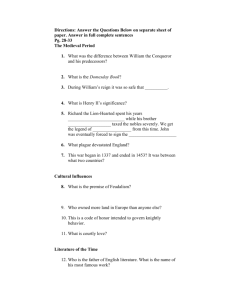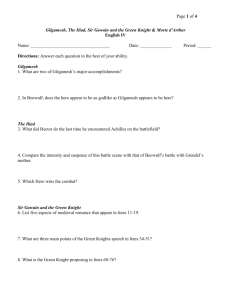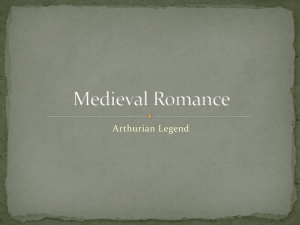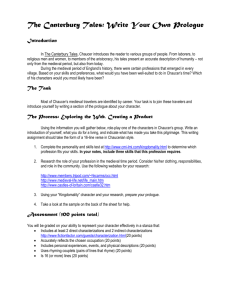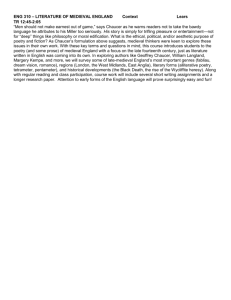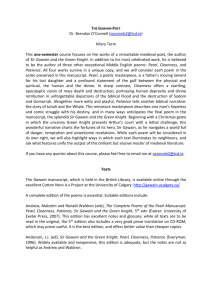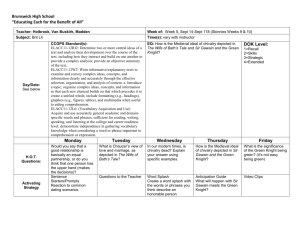Middle Ages – Notes and Quotes (You will be quizzed on this
advertisement
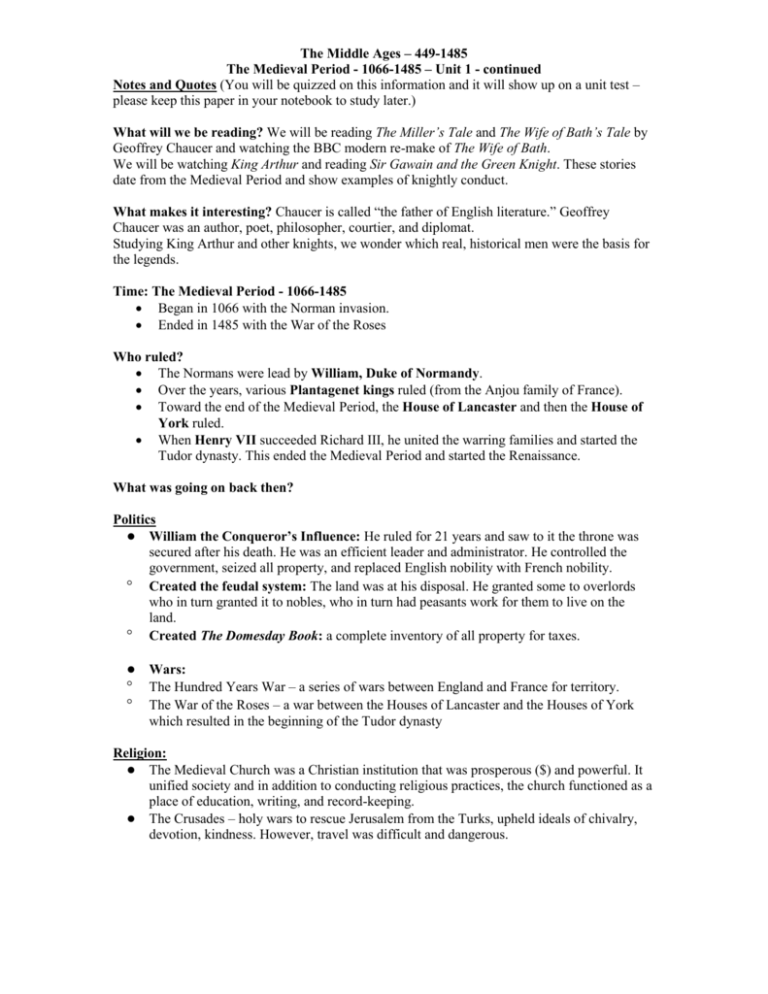
The Middle Ages – 449-1485 The Medieval Period - 1066-1485 – Unit 1 - continued Notes and Quotes (You will be quizzed on this information and it will show up on a unit test – please keep this paper in your notebook to study later.) What will we be reading? We will be reading The Miller’s Tale and The Wife of Bath’s Tale by Geoffrey Chaucer and watching the BBC modern re-make of The Wife of Bath. We will be watching King Arthur and reading Sir Gawain and the Green Knight. These stories date from the Medieval Period and show examples of knightly conduct. What makes it interesting? Chaucer is called “the father of English literature.” Geoffrey Chaucer was an author, poet, philosopher, courtier, and diplomat. Studying King Arthur and other knights, we wonder which real, historical men were the basis for the legends. Time: The Medieval Period - 1066-1485 Began in 1066 with the Norman invasion. Ended in 1485 with the War of the Roses Who ruled? The Normans were lead by William, Duke of Normandy. Over the years, various Plantagenet kings ruled (from the Anjou family of France). Toward the end of the Medieval Period, the House of Lancaster and then the House of York ruled. When Henry VII succeeded Richard III, he united the warring families and started the Tudor dynasty. This ended the Medieval Period and started the Renaissance. What was going on back then? Politics ● William the Conqueror’s Influence: He ruled for 21 years and saw to it the throne was secured after his death. He was an efficient leader and administrator. He controlled the government, seized all property, and replaced English nobility with French nobility. Created the feudal system: The land was at his disposal. He granted some to overlords who in turn granted it to nobles, who in turn had peasants work for them to live on the land. Created The Domesday Book: a complete inventory of all property for taxes. ● Wars: The Hundred Years War – a series of wars between England and France for territory. The War of the Roses – a war between the Houses of Lancaster and the Houses of York which resulted in the beginning of the Tudor dynasty Religion: ● The Medieval Church was a Christian institution that was prosperous ($) and powerful. It unified society and in addition to conducting religious practices, the church functioned as a place of education, writing, and record-keeping. ● The Crusades – holy wars to rescue Jerusalem from the Turks, upheld ideals of chivalry, devotion, kindness. However, travel was difficult and dangerous. The Middle Ages – 449-1485 The Medieval Period - 1066-1485 – Unit 1 - continued Literature: There were many forms of writing: autobiography, travel writing, devotional writing, poems, romances, and plays. Romances were the most popular form of writing; they told tales of chivalry, love and the supernatural marvels like dragons, giants, wizards and sorceresses. The invention of the printing press made texts more accessible to the public. People: ● Medieval life: Life was austere, meaning simple, without many extravagances. To reward themselves for a life of hard work, there were religious festivals, tournaments with brilliant pageantry. This kept the people content. ● Culture: Anglo and Norman cultures blended. ● Business: The wool industry was the main business of England. (Sheep everywhere!) Commoners were herders and farmers. A new class of merchants evolved (This allowed some people to buy their way into the nobility.). Guilds emerged to regulate workmanship and commerce. ● The Black Death – the plague of 1348 that killed over 1/3 of the population of England. The plague affected the feudal system because it killed so many of the commoners. Also, peasants revolted because of the weakened state of the nobility. ● The Legal System: a few important developments occurred during the Medieval Period. common law – law for everyone Magna Carta – limited the king’s power Primogeniture – the first born inherited everything Notes: The Canterbury Tales: TIME AND PLACE WRITTEN · Around 1386–1395, England Chaucer’s Goal: Chaucer’s plan was for each of his pilgrims to tell two stories on the way to the shrine of St. Thomas a Becket and two on the return journey to London. Chaucer died before this plan was realized and, instead of the proposed 124 stories, he wrote only twenty-four. DATE OF FIRST PUBLICATION · Sometime in the early fifteenth century NARRATOR · The primary narrator is an anonymous, naïve member of the pilgrimage, who is not described. The other pilgrims narrate most of the tales. POINT OF VIEW · In the General Prologue, the narrator speaks in the first person, describing each of the pilgrims as they appeared to him. Though narrated by different pilgrims, each of the tales is told from an omniscient third-person point of view, providing the reader with the thoughts as well as actions of the characters. This is a frame story, or stories within a story. TONE · The Canterbury Tales incorporates an impressive range of attitudes toward life and literature. The tales are by turns satirical, elevated, pious, earthy, bawdy, and comical. The reader should not accept the naïve narrator’s point of view as Chaucer’s. TENSE · Past SETTING (TIME) · The late fourteenth century, SETTING (PLACE) · The Tabard after 1381 Inn; the road to Canterbury The Middle Ages – 449-1485 The Medieval Period - 1066-1485 – Unit 1 - continued Quotes: From King Arthur: Arthur: Knights! The gift of freedom is yours by right. But the home we seek resides not in some distant land, it's in us, and in our actions on this day! If this be our destiny, then so be it. But let history remember, that as free men, we chose to make it so! (Arthur believes that even if it’s their destiny to fight in the battle, as free men they made the choice to do so.) Arthur: Deeds themselves are useless unless they are for some higher purpose (This statement shows that there must be a reason for your actions; otherwise, they are meaningless.). Tristan: We knights are blessed in that we do not run from it. We seek it, grasp it by the throat and demand honor in our passing. (This statement shows that knights valued honor, a part of their knightly conduct.) From Sir Gawain and the Green Knight Narrator: “He tried to seem fearless, but his knees were weak.” Though Gawain is supposed to be a brave knight, even he has fear. The Green Knight: “Gawain, you can’t be Gawain. His name is too noble and he’s never afraid.” He refers to Gawain flinching at his strike, something a brave knight with Gawain’s reputation shouldn’t do. The Green Knight: “An honest man need never fear.” He points out Gawain wasn’t completely honest when he kept the belt from his wife. The Green Knight: “But you failed a little, lost good faith – not for a beautiful belt, or in lust, but for love of your life.” He points out Gawain’s weakness is that he loved his life too much and allowed his honor to falter. Gawain : “A curse on cowardice and a curse on greed. They shatter chivalry, their vice destroys virtue.” He is disappointed in himself for being weak and afraid. He feels he has compromised the ideals of knightly conduct. Setting: King Arthur: The island of Britain around the 400’s Sir Gawain and the Green Knight: a chapel in Wales during Christmas season
